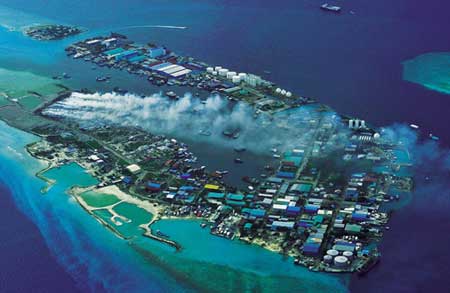當前位置: Language Tips> 雙語新聞
The beautiful island in the Maldives that's been reduced to a pile of rubbish
分享到
 |
|
Smoke rising from refuse on Thilafushi. Attention has been turned on the environmental damage; large amounts of asbestos, lead and other toxic metals have been dumped into the lagoon.(Agencies) |
|
Three-quarters of a million tourists flock to the pristine, white beaches every year - but this booming industry has come at a price. When the influx of foreigners left the government struggling to cope with a relentless stream of rubbish, their answer was to turn one of this islands into a dumping ground. Clouds ofpungent, toxic smoke rising from open fires, piles of filth made up of plastic bottles, crisp packets and consumer detritus... it'sa far cry fromthe white sands, crystal-clear waters and gently swaying palm trees that we associate with the Maldives, the quintessential paradise island holiday destination set in the Indian Ocean. Of its 200 inhabited islands, which are spread across an area of 35,000 square miles, 99 are dedicated resorts. Three-quarters of a million tourists visit every year – more than double the domestic population. Of these, over 100,000 travel from the UK. The capital, Malé, is four times more densely populated than London. Given these facts, it's hardly surprising that the Maldives has a waste disposal problem. What you are seeing here is a view of the Maldives on which no honeymooners will ever clap eyes. Four miles west of Malé is the country's dumping ground, Thilafushi – or Rubbish Island as it has simply become known. The country dumps upwards of 330 tons of rubbish on the island every day, a figure attributed largely to the tourist industry on which the chain of atolls relies. Each visitor generates 3.5kg of waste per day. Now, the government of the Maldives has belatedly banned the dumping of waste on the island, due largely to an increase in the number of waste boats 'fly-tipping' directly into the sea, fed up with waiting seven hours or more to offload their cargo. The freighters are now ferrying debris to India instead. (Read by Emily Cheng. Emily Cheng is a journalist at the China Daily Website.) (Agencies) |
每年,全球有75萬名游客來到純凈的馬爾代夫海灘,但繁榮的旅游業也讓當地付出了代價。大量外國游客持續遺留下的垃圾令當地政府疲于應對,不得不將一座島嶼變成垃圾場。 焚燒垃圾產生的氣體刺鼻有毒,塑料瓶、包裝紙、游客丟棄的雜物堆積成山,這與白色沙灘、清澈透明的海水以及搖曳的棕櫚樹等我們對馬爾代夫的印象格格不入。這座經典的度假勝地“天堂島”座落在印度洋。 馬爾代夫有人居住的200座島嶼分布在3.5萬平方英里的海洋上,其中99座已專門開發成度假勝地。 每年有75萬人來馬爾代夫旅游,是當地人口的兩倍多。這其中有超過10萬名游客來自英國。 馬爾代夫首都馬累的人口密度是倫敦的4倍。因此馬爾代夫的垃圾處理難題就不足為奇了。 你在這里看到的,是去馬爾代夫度蜜月的情侶們絕不會看到的情景。 斯拉夫士島在馬累西部四英里,這里是馬爾代夫的垃圾傾倒場,簡單說也就是人們所說的“垃圾島”。 馬爾代夫每天在該島上傾倒超過330噸垃圾,垃圾成山大部分原因是島國馬爾代夫依賴旅游產業。每位游客每天產生3.5公斤垃圾。 如今,馬爾代夫政府已經禁止再向該島傾倒垃圾,這主要是因為越來越多的垃圾船不愿等待7個小時甚至更久的時間卸貨,而直接向海里“違法傾倒”。現在,垃圾船改為將垃圾運往印度。 相關閱讀 (中國日報網英語點津 Julie 編輯:旭燕) |
|
Vocabulary: pungent: 刺激性的,辛辣的 a far cry from: 相距甚遠,完全不同 fly-tipping: 違章傾倒廢物,違法倒垃圾 |
上一篇 : 中國冠毛犬獲評世界最丑狗
下一篇 : 2020年全球大學畢業生或短缺?
分享到
關注和訂閱


電話:8610-84883645
傳真:8610-84883500
Email: languagetips@chinadaily.com.cn